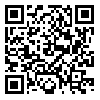Volume 9, Issue 6 (2018)
LRR 2018, 9(6): 157-186 |
Back to browse issues page
Download citation:
BibTeX | RIS | EndNote | Medlars | ProCite | Reference Manager | RefWorks
Send citation to:



BibTeX | RIS | EndNote | Medlars | ProCite | Reference Manager | RefWorks
Send citation to:
Farshbafian A, Safaei Asl E, Aram Y. Typology of Theme System in Persian and Azeri Turkish. LRR 2018; 9 (6) :157-186
URL: http://lrr.modares.ac.ir/article-14-24012-en.html
URL: http://lrr.modares.ac.ir/article-14-24012-en.html
1- Assistant Professor of Persian language and Literature, Tabriz University
2- Alumnus in Linguistics, PhD, Allameh Tabataba'i University ,safai.atu@gmail.com
3- Assistant Professor of Linguistics, Bu-Ali Sina University, Hamedan
2- Alumnus in Linguistics, PhD, Allameh Tabataba'i University ,
3- Assistant Professor of Linguistics, Bu-Ali Sina University, Hamedan
Abstract: (8995 Views)
In systemic functional typology, which studies the systems of languages rather than the whole languages, linguists strive towards empirical generalizations that in principle apply to all languages around the world. In line with the above-mentioned goal of systemic functional typology and having examined the ideational (logical and experiential), interpersonal, and textual systems of the ‘clause grammar’ of different and various languages, Matthiessen (2004) has achieved a series of typological generalizations/universals. In connection with his proposed typological generalizations, Matthiessen (2004) has argued that they can be applied in the description of any language and in the attempt to expand the typological explanations in the framework of systemic functional grammar as well. However, he has immediately stated that “It is not yet possible to propose a generalized map; but we have to move in that direction.”
In line with Matthiessen’s claim mentioned above, the present paper has attempted to describe the THEME system of Azeri Turkish on the one hand and compare it with the THEME system of Persian language on the other hand. This research has been conducted in terms of the following three typological parameters concerning the THEME system: (1) The treatment of unmarked and marked THEME (related to the subsystem of THEME MARKEDNESS), (2) The relationship between THEME and MOOD (related to the subsystem of THEME SELECTION), and (3) The relationship between experiential (topical) THEME and interpersonal and textual THEME (related to the subsystems of THEME TYPE, INTERPERSONAL THEME, and TEXTUAL THEME).
Studying typological behaviors of the Azeri Turkish THEME system in the framework of Matthiessen (2004)’s typological generalizations and comparing those behaviors with the typological behaviors of the Persian THEME system show that the two languages of Persian and Azeri Turkish (1) have an almost identical thematic structure, (2) treat both unmarked and marked Themes similarly, (3) have multiple types of Themes beside simple ones, (4) treat the elements of a multiple Theme similarly, and (5) have a MOOD-free THEME system. These findings show that both languages, which are genealogically different, have a similar THEME system and specifically the three subsystems of THEME MRKEDNESS, THEME SELECTION, and THEME TYPE. This result is consistent with ‘axial principle of congruence’. According to this principle, languages tend to be more congruent with one another in terms of paradigmatic axis/system than in terms of syntagmatic axis/structure.
In the end, it is suggested that the typological behaviors of the THEME system of other languages spoken in Iran be identified and introduced in the aforementioned framework.
In line with Matthiessen’s claim mentioned above, the present paper has attempted to describe the THEME system of Azeri Turkish on the one hand and compare it with the THEME system of Persian language on the other hand. This research has been conducted in terms of the following three typological parameters concerning the THEME system: (1) The treatment of unmarked and marked THEME (related to the subsystem of THEME MARKEDNESS), (2) The relationship between THEME and MOOD (related to the subsystem of THEME SELECTION), and (3) The relationship between experiential (topical) THEME and interpersonal and textual THEME (related to the subsystems of THEME TYPE, INTERPERSONAL THEME, and TEXTUAL THEME).
Studying typological behaviors of the Azeri Turkish THEME system in the framework of Matthiessen (2004)’s typological generalizations and comparing those behaviors with the typological behaviors of the Persian THEME system show that the two languages of Persian and Azeri Turkish (1) have an almost identical thematic structure, (2) treat both unmarked and marked Themes similarly, (3) have multiple types of Themes beside simple ones, (4) treat the elements of a multiple Theme similarly, and (5) have a MOOD-free THEME system. These findings show that both languages, which are genealogically different, have a similar THEME system and specifically the three subsystems of THEME MRKEDNESS, THEME SELECTION, and THEME TYPE. This result is consistent with ‘axial principle of congruence’. According to this principle, languages tend to be more congruent with one another in terms of paradigmatic axis/system than in terms of syntagmatic axis/structure.
In the end, it is suggested that the typological behaviors of the THEME system of other languages spoken in Iran be identified and introduced in the aforementioned framework.
Keywords: Systemic functional typology, Mathiessen’s typological generalizations, Theme system, Persian, Azeri Turkish.
Send email to the article author
| Rights and permissions | |
 |
This work is licensed under a Creative Commons Attribution-NonCommercial 4.0 International License. |







